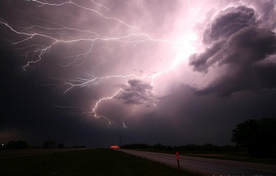The safest location during a thunderstorm is inside a building with plumbing and electrical wiring. If lightning strikes the building, the plumbing and wiring will conduct the electricity and eventually direct it into the ground. If no buildings are available, then an enclosed metal vehicle such as an automobile, van, or school bus would be a suitable alternative.
Watch for dark clouds and increased wind; or if you hear thunder, it’s time to seek shelter. Other safety measures include:
- Avoid leaning against cars, fences or gates, construction equipment or trees. Avoid standing on scaffolding or metal ladders as each of these items may be energized if struck by lightning.
- Refrain from touching concrete surfaces. Lightning can travel through the metal wires or bars in concrete walls and flooring.
- If inside a vehicle, roll up the windows and avoid contact with any conducting paths leading to the outside of the vehicle (e.g. metal surfaces, ignition and portable electronic devices plugged in for charging).
OSHA requires that employers adequately train all workers on lightning safety. Training should be provided for each outdoor worksite, so that supervisors and workers know in advance where a worksite’s safe shelters are and the time it takes to reach them. Employers should train supervisors and workers to provide lightning safety warnings in sufficient time for everyone to reach a worksite’s safe shelters and take other appropriate precautions.


 RSS Feed
RSS Feed
